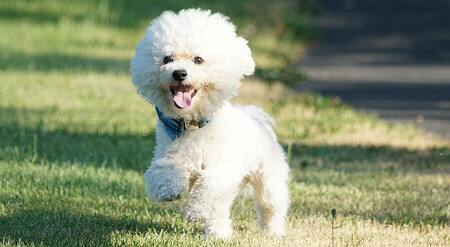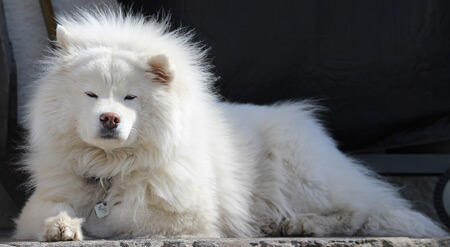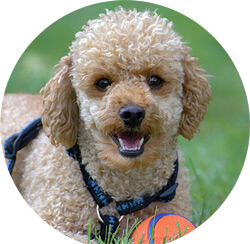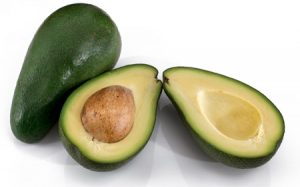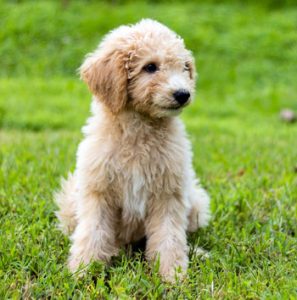People who have pet allergies can own breeds from this non-shedding, hypoallergenic dogs list. Most non-shedding dogs and allergy free cats don’t shed a lot of hair and dander. In the list are tiny, small, medium-sized, big and large allergy-free dogs.
All Low-Shedding Dog Breeds (With Pictures)
1. Basenji

About 8% of all pet allergies are caused by dogs. Note that dog allergens are also found in dander, urine, serum and hair. However, a dog’s saliva has the most allergens.
There are over 29 dog allergens in total. However, most allergies are caused by the 5 major allergy-causing dog proteins. These are: Can f 1 and Can f 2 (in saliva, skin and dander), Can f 3 (in serum), Can f 4 (in skin, hair and dander) and Can f 5 that is secreted in a dog’s urine.
Quick Answers about Hypoallergenic Dog Breeds
What dogs are hypoallergenic?
Hypoallergenic dogs are the breeds that produce very little of these major dog allergens. In addition, there are some cross breeds that are hypoallergenic. They are commonly referred to as mixes or hybrids, between a purebred hypoallergenic breed and an allergy causing breed.
But note that no dog breed is 100% hypoallergenic.
What does hypoallergenic dog mean?
Being hypoallergenic simply means that the dog is less likely to cause allergic reactions in people who have pet allergies.
What dog breeds are hypoallergenic?
There are all kinds of hypoallergenic dog breeds. Some are tiny – including the Toy Poodle, Chinese Crested Dog and Affenpinscher. Other hypoallergenic dog breeds are of medium size, as well as big allergy-free dogs. They are listed below and grouped by size.
Can you be allergic to hypoallergenic dogs?
Yes. A dog breed that doesn’t cause allergies to one allergy sufferer may cause allergies to another allergic person. It mostly depends on a person’s sensitivity to dog allergens, grooming standards and the level of interaction.
For example, allowing a dog to lick you will expose you to more dog allergens. Regular bathing and brushing greatly help to reduce the amount of dog allergens on dogs and around the home.
Do hypoallergenic dogs shed?
Some hypoallergenic dogs, like the big Samoyed, shed heavily. Others shed less, while a few are hairless.
But it’s good to note that all dogs that have hair must shed. This is because shedding is a natural process. Shedding helps regulate body temperature and allows the growth of a new, healthy coat.
What are some good and badass dog names for hypoallergenic breeds?
Good dog names for non-shedding breeds include Coco, Max, Sam, Buddy, Diva, Astra, Adonis, Ace, Cuddles, Dolly, Sunny and Leo.
Are Bernese Mountain Dogs hypoallergenic?
No. Bernese Mountain Dogs are not hypoallergenic. But they are big and strong.
Are Pomeranians hypoallergenic dogs?
No. Pomeranians are not hypoallergenic. But they are cheerful and fluffy.
Are Yorkies hypoallergenic dogs?
Yes. Yorkies (Yorkshire Terriers) are great for people who have allergies.
What makes a dog hypoallergenic?
All dogs produce dog allergens. But some breeds produce very little of the major allergens. This is what makes a dog hypoallergenic.
What kind of dogs are hypoallergenic?
Hypoallergenic dogs come in all sizes, shape, temperaments and colors – and have cool dog names. As a result, there’s an allergy-free dog for everyone!
No Breed is 100% Hypoallergenic
Moreover, breeds on this list of all hypoallergenic dogs produce less dog allergens. Dog allergens are the protein that cause allergic reactions.
However, many people assume that it’s the shed hair that gives them allergies. As a result, all breeds of dogs that don’t shed much are getting popular with pet owners.
But no cat or dog breed is 100% hypoallergenic.
Moreover, dog allergens are concentrated in their saliva. The allergies caused by dogs are actually caused by the Can f 1, Can f 2 and Can f 5 protein. These protein are also found in the dog’s dander (dead skin) and urine.
Likewise, cats that don’t shed much such as Sphynx and Russian Blue produce less Fel d 1 protein. Being allergic to dogs and cats is common. However, those affected by cat allergies are twice the number of dog allergy sufferers.
All Hypoallergenic Dogs List: Best Breeds for People with Allergies
Below is a list of all non-shedding dogs. The list includes small or toy, and medium-size allergy-free dog breeds. We have also included a list of big and large hypoallergenic dogs.
Which are the Most Popular Non-shedding Dogs?
The most popular dogs that don’t shed include:
- Poodle
- Yorkshire Terrier
- Miniature Schnauzer
- Shih Tzu
- Havanese
- Maltese
- Bichon Frise
- Samoyed
- Giant Schnauzer
- Coton de Tulear
Small Hypoallergenic Dogs
Most of the non-shedding dogs are either toy or small in size. They are more popular. In addition, small dogs generally live longer than large breeds.
All Small Hypoallergenic Dogs List
- Shih Tzu
- Toy Poodle
- Brussels Griffon
- Affenpinscher
- Bichon Frise
- Maltese
- Havanese
- Italian Greyhound
- Lhasa Apso
- Lowchen (Little Lion Dog)
- Miniature Schnauzer
- Bolognese
- Mi-Ki
- Chinese Crested Dog
- Coton de Tulear
- Lagotto Romagnolo
- West Highland White Terrier
- Lakeland Terrier
- Dandie Dinmont Terrier
- Border Terrier
- Cairn Terrier
- Cesky Terrier
- Sealyham Terrier
- Yorkshire Terrier
- Norfolk Terrier
- Norwich Terrier
- Scottish Terrier (Scottie)
- Bedlington Terrier
- American Hairless Terrier
- Australian Terrier
- Silky Terrier
Small dog breeds eat less and are great couch potatoes. In addition, they can comfortably live indoors. However, small dogs are still energetic and need enough exercise!
Medium-Sized Hypoallergenic Dogs
A medium-sized dog weighs from about 9 kg (20 pounds) to around 27 kg (60 pounds). In addition, they have a height of between 8 and 27 inches at the withers (shoulders). However, the runts (read more about runts here) of these mid-size dogs will be small in size while some puppies will grow to be big dogs.
But on average, the purebred parents of the following dog breeds will produce mid-sized offspring.
List of All Medium-sized Non-shedding Dogs
- Basenji
- Miniature Poodle
- Xoloitzcuintli (Xolo/ Mexican Hairless Dog)
- Hairless Khala
- Irish Terrier
- Kerry Blue Terrier
- Tibetan Terrier
- Welsh Terrier
- Wirehaired Fox Terrier
- Soft Coated Wheaten Terrier
- Peruvian Inca Orchid
- Polish Owczarek Nizinny/ Polish Lowland Sheepdog
- Puli
- Barbet
- Spanish Water Dog
- Standard Schnauzer
- Wirehaired Pointing Griffon
Big Hypoallergenic Dogs
The following is the list of big non-shedding dogs. They are some of the best working dogs. But unlike small dogs, most big dogs love living outdoors. Consequently, they make great guard dogs and shepherd dogs. Moreover, some of these big dogs are good hunting dogs.
Large Non-allergenic Dogs List
- Samoyed
- Giant Schnauzer
- Portuguese Water Dog
- Bergamasco shepherd
- Afghan Hound
- Standard Poodle
- Airedale Terrier
- Bouvier des Flandres
- Irish Water Spaniel
A common feature among many big dog breeds is that they are big and brave, yet very gentle and protective.
Hairless Hypoallergenic Dog Breeds
Most hairless dog breeds (except the American Hairless Terrier) have a dominant hairlessness or hair loss gene. As a result some puppies in a litter may have hair.
Here is a list of all hairless dog breeds that are great for people who have pet allergies.
- American Hairless Terrier
- Chinese Crested
- Xolo/ Xoloitzcuintle
- Hairless Khala (Bolivian Hairless Dog)
- American Crested Sand Terrier
- Peruvian Inca Orchid (PIO)
- Ecuadorian Hairless Dog
- Abyssinian Sand Terrier/ African Hairless Dog
- Argentine Pila Dog
Best Hypoallergenic Guard Dogs
The following are the best hypoallergenic dogs for guard duties. They are arranged in alphabetical order. The list includes small, medium-sized and big hypoallergenic guard dogs.
- Airedale Terrier
- Australian Terrier
- Bedlington Terrier
- Bouvier des Flandres
- Giant Schnauzer
- Irish Terrier
- Kerry Blue Terrier
- Komondor
- Lhasa Apso
- Norfolk Terrier
- Poodle
- Portuguese Water Dog
- Puli
- Samoyed
- Shih Tzu
- Tibetan Terrier
- Wheaten Terrier
- Wirehaired Pointing Griffon
Best Hypoallergenic Mixes
There are many hypoallergenic crossbreeds. These are mixes between two or more purebred dogs. Crossbreeds will usually have both hypoallergenic and shedding puppies in the same litter. The F1 generation, however, have hybrid vigor. This means that they inherit the best qualities of both purebred parent breeds. Popular allergy-free Poodle mixes include the Goldendoodle, Labradoodle and Bernedoodle.
The best hypoallergenic dogs mixes include:
- Bernedoodle (Poodle + Bernese Mountain Dog)
- Chi-Poo (Poodle + Chihuahua)
- Goldendoodles (Poodle + Golden Retriever)
- Labradoodle (Poodle + Labrador Retriever)
- Cockapoo (Poodle + Cocker Spaniel)
- Shepadoodle (Poodle + German Shepherd)
- Bichon Yorkie/ Yorkie Bichon (Bichon Frise + Yorkshire Terrier)
- Bordoodle/ Borpoo/ Borderdoodle/ Borderpoo (Border Collie + Poodle)
- Chacy Ranior/ Shichon (Bichon Frise + Shih-Tzu)
- Morkie (Maltese + Yorkshire terrier)
- Morkiepoo (Morkie + Mini Poodle)
- Malshi/ Mal-Shih/ MalShih/ Malt-tzu/ Maltzu/ and Malti-zu (Shih Tzu + Maltese)
Got Allergies? Avoid your Pet’s Saliva, Urine and Dander
Cats and many dogs spend a lot of time grooming themselves – and spreading allergens all over themselves. Cats cause more allergies than dogs. However, dog allergies tend to be more severe. Common pet allergy symptoms include:
- Sneezing
- Hives and rashes on skin
- Running nose
- Nasal congestion
- Red, watery eyes
Dogs that have allergies also experience most of these symptoms. But allergies in dogs are easily managed using CBD oil for dogs.
Best Ways to Reduce dog Allergies
Now that no dog breed is 100% hypoallergenic, how can I reduce the chances of getting dog allergies?
A dog’s saliva, urine and dander are mostly responsible for the allergic reactions people have towards dogs. The following are the best ways to reduce the chances of getting allergic reactions to our most-loved pets.
- Wash your hands – this is the easiest way to reduce contact with dog allergens
- Change your clothes after coming into contact with dogs and cats
- Dust and vacuum your home daily – this will greatly reduce the amount of dander at home
- Do not let a dog enter your bedroom – Most dander and hair are found in hard-to-reach places, including on mattresses, carpets and wooden surfaces. As a result, it is best to get your dog her own bed
- Use air purifiers and filters inside your house. The best of these catch up to 99% of allergens
- Groom your dog regularly – Regular brushing helps to remove loose hairs. It also helps dogs maintain a healthy coat!
- Be aware that female dogs and cats generally produce less allergens. In addition, neutered males have less allergens.
- Regularly bathe your dog – a dog shampoo is highly recommended to ensure that your best friend will have less allergens. Moreover, bathing leaves dogs clean and smelling great!
- Regularly wash and air your pet’s beddings. In addition, remember to scrub his favorite resting places
More ways to Reduce Dog and Cat Allergies
- If possible, have your friend or another family member who doesn’t have pet allergies clean your pet’s litter boxes and do grooming duties
- Give your dog a balanced diet – Poor nutrition causes dogs to shed more than normal
- Watch out for parasites – both internal and external parasites cause poor health. They also increase the rate of shedding. In addition, dogs who have fleas shed a lot more whenever they scratch themselves
- Encourage your dog to spend more time outdoors, for example in a dog park. This will reduce the concentration of dog allergens indoors
- Ensure your pet gets regular exercises – not only will he/ she be healthier, but the dog will also shed more hair and dander outside the home area
- Information is power, so be well informed. The Asthma and Allergy Foundation of America and the American Kennel Club (AKC) are some of the online resources that have great information about allergies
Spend Time with a Dog to be Sure
Coming into contact with a cat or dog’s saliva, urine and dander are the main ways through which allergens reach people. But many pet allergy sufferers experience mild reactions. This is why dogs that shed the least and allergy free cats such as the Russian Blue provide a relief to people who have pet allergies.
It is good to spend time with any allergy-free dog, preferably at the breeder, before you take her home. This is the only way to be sure that you will not be allergic to the puppy’s saliva, urine and dander. However, people with pet allergies should definitely try some of the dogs from this list of all hypoallergenic dog breeds.
Share On Your Favorite Social Media!
Use the following links to spread the word...
